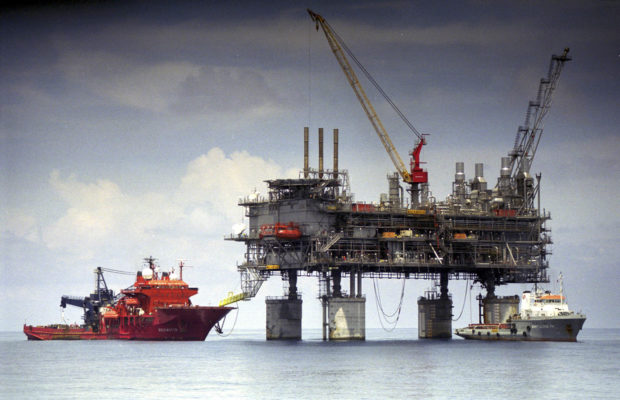
The Malampaya topsides-heaviest and largest integrated platform topsides deck ever built in the Asia Pacific region installed using the “float-over” technique eighty kilometers offshore Northwest Palawan. EDWIN BACASMAS
The Commission on Audit has called for an “immediate” investigation on Department of Budget and Management and other government agencies over anomalies in the use of P36.288 billion in royalties from the Malampaya gas fields from 2004 to 2012.
COA’s Sectoral Performance Audit report, released this week, stated that “in general, releases of funds by the DBM, out of the Malampaya Fund, to the different [implementing agencies] may not be considered proper.”
The said audit covered funds which were released not for energy development-related purposes, but for “other purposes authorized by the President”—a practice struck down by the Supreme Court as unconstitutional in November 2013.
Not only were the funds intended for unconstitutional purposes, auditors revealed “the apparent disregard of applicable laws, rules, and regulations which contributed to the misuse of funds.”
For one, auditors flagged the lack of documentary requirements to establish the basis for the release of the P36.288-billion funds to 62 implementing agencies.
The report also cited the DBM’s failure to establish first the propriety of the projects to be funded and the reasonableness of the requested amounts. It also noted that as much as P2.171 billion of the funds were diverted to purposes other than those authorized by the President.
“The [audit] team recommends immediate conduct of investigation to determine officials and employees who may be responsible for the questionable release of funds and file appropriate charges, if warranted,” the report read.
It urged the DBM to thoroughly evaluate the “actual needs” of the agencies requesting the Malampaya Funds and ensure the completeness of their documents first.
Not energy-related
The audited funds were released during six years of the Arroyo administration under Secretaries Emilia Boncodin, Romulo Neri and Rolando Andaya Jr. (now representative of Camarines Sur 1st district), and two years of the Aquino administration under Secretary Florencio Abad.
As of May 21, 2012, as much as P38.807 billion—22.41 percent of the P173.28 billion paid to the national government as of June 30, 2013—were released for “other purposes as may be directed or authorized by the President,” instead of for energy resource development and exploitation.
“The very purpose for which Malampaya Fund was established is therefore yet to be served,” said COA, which was prompted by the Supreme Court case to look into all funds released just on the President’s say-so.
The report specifically zeroed in on P36.288 billion worth of fund releases to national government agencies, as a separate fraud audit covered the P2.572 billion allotted to the projects of the Palawan provincial government.
In the case of the audited funds under 184 special allotment release orders, the mandatory documents required prior to the approval of the disbursement could not be located.
COA took this as a sign of DBM’s failure to “properly evaluate and establish the basis for the release of Malampaya funds.”
Such documents include the endorsement of the Department of Energy, the DBM’s evaluation, or even the fund requests from the implementing agencies. DBM claimed it could not submit the results of its evaluation to the COA audit team because these were “classified internal documents.”
The Armed Forces of the Philippines General Headquarters accounted for the largest portion of unsupported releases at P7.268 billion, followed by the Department of Public Works and Highways at P7.103 billion, the National Power Corp. at P6.624 billion, and the Department of Agriculture at P5.824 billion.
Other agencies that received substantial irregular disbursements were: Philippine National Police (P2.14 billion), National Electrification Administration (P1.922 billion), Department of Energy (P1.91 billion), National Housing Authority (P1.399 billion), Department of Agrarian Reform (P900 million), and Department of Health (P745.926 million).
Reasonable cost not checked
Instead of requiring certain documents to serve as basis for the allocations, auditors said DBM only required the said documents for compliance under the SAROs that released the funds already.
This out-of-order set-up meant DBM lacked the documentary requirements to check the basis for the fund releases and the reasonableness of the requested amounts.
Auditors said “DBM does not have an idea on whether the project was necessary or not,” which “clearly manifested that the DBM released the funds without thorough evaluation.”
Not only that, DBM did not submit documents to show that it really monitored the compliance of the agencies with the requirements of the SAROs.
Diverted funds
Meanwhile, 24 releases totaling P2.171 billion were diverted by DBM for purposes other than those authorized by the President, in violation of Section 8 of Presidential Decree No. 910.
“Examination of the documents submitted by the DBM however disclosed that this provision was not strictly observed,” auditors noted.
President Gloria Macapagal-Arroyo in October 2009 approved the use of these amounts for relief operations and rehabilitation of areas affected by the widespread devastation of several typhoons.
But DBM ended up issuing 10 SAROs to PNP for the purchase of various supplies (P877.63 million), “operations and other related activities against dissidents, subversive lawless elements and organized crime syndicates” (P489.8 million), intelligence activities (P303.07 million), and human resource development (P80 million).
Only P10 million ended up covering the repairs of Philippine Military Academy infrastructure actually damaged by the typhoons.
Also questioned was the P100-million tranche released to DOE for the “Coron waterfront development project.”
“Clearly, the specific purpose for which the fund was released…was no longer aligned with the purpose for which the fund release was approved by the President,” COA said.